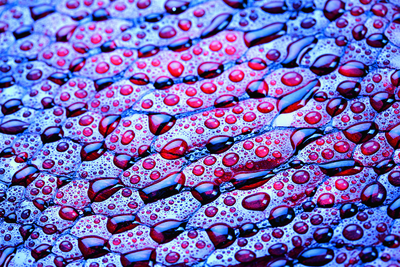The high gloss raised effect produced by Scodix shows to good effect in the droplets.
Metallics, foils and raised imaging effects are starting to appear for digital production, with benefits of low setup costs, short runs and variability. Simon Eccles looks at what’s here and what’s coming.
It is safe to say that full colour digital production printing is now widely accepted, to the point that its use is uncontroversial for the sort of short run or variable work it is best at. However, the vast majority of digital print is just that: full colour print. There is no lift, no boost to make it stand out. It is flat and mostly confined to CMYK colours. More exotic effects with special colours, metallics and embossing have mostly needed traditional, expensive, nonvariable analogue processes.
This is set to change as the past year or two have seen an acceleration in the introduction of new digital special effects for print: in particular, raised and textured images that simulate embossing and thermography, plus super-glossy spot UV coatings, and metallised effects. These systems maintain all advantages of digital printing, (personalisation, fast response, low set-up costs), while giving the material a whole new look and feel. Sometimes, literally a new feel.
Embossing
By putting down extra layers of clear ink or toner, some digital presses can create a raised effect. Sometimes it is subtle, so you notice it when you brush your fingers across it or it catches the light.
Other methods produce an effect that is so high it resembles embossing, a mechanical effect that previously required expensively tooled metal dies. Digital embossing works for short runs and does not require you to pay a packet and wait for a metal die to be cut.
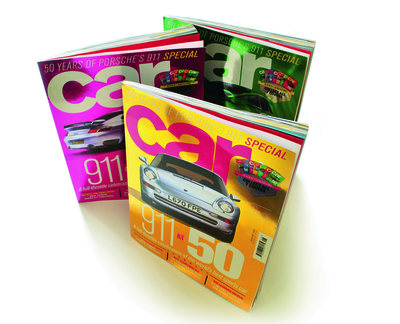 CAR magazine’s August issue offered a choice of seven different covers to celebrate the 50th anniversary of the Porsche 911. These were printed on different coloured Mirri foil, which was pre-laminated to the normal cover stock.
CAR magazine’s August issue offered a choice of seven different covers to celebrate the 50th anniversary of the Porsche 911. These were printed on different coloured Mirri foil, which was pre-laminated to the normal cover stock.
The first digital embossing systems were announced about five years ago. Kodak introduced Dimensional Clear Dry Ink (which is actually a toner powder) for the fifth unit of Nexpress models. This runs with modified fusers to achieve heights up to 28 microns. The height can be varied to create textures such as leather or canvas, controlled by a separate greyscale layer in the digital artwork.
Last year Xerox demonstrated a similar ability on its Color 800 and 1000 SRA3 toner presses, which can print clear toner on their fifth units. Modestly raised effects can be achieved by multiple passes through the press.
In 2008, Roland DG introduced its first UVcured wide format inkjet, the VersaUV LEC- 300, which can build up multiple layers of UV-cured clear ink. This slows the printer down but allows quite striking raised and textured effects to be achieved, as well as Braille for signage, packaging proofing and the like. Since then the LEC range has been broadened out to the faster 30 inch LEC-330 and the 54 inch LEC-540.
Duncan Jefferies at Hybrid said that Mimaki has been able to print raised UV ink since 2005 (he has a sample to prove it). However, Mimaki has not promoted this feature as vigorously as Roland.
At drupa last year HP introduced two ways of achieving a raised effect with its Indigo presses. The first is to build up the height with multiple passes of transparent ink on the substrate on the printing cylinder – up to 20 – on the 5500, 7500 and 7600 presses.
This works well and is praised by Lawrence Dalton, managing director of 1st Byte, who has been offering it for effects work for the past year. He said that although it slows down the press and costs more in click charges, it is still cheaper than die embossing, and is also variable.
The other method is to build up a raised layer from ink on a packing paper under the impression cylinder, and then to run the final substrate over that, where it produces a genuine but fairly light embossing. Mr Dalton said this does not work as well as the raised ink in his experience.
Inkjet embossers
Two manufacturers now offer dedicated raised-image ’embossing’ inkjet presses. Scodix was first to market with its Scodix1200 B2 model at Ipex 2010. This has now been developed into a range of four presses, the B3+ S52 and B1+ S75 and S75 Pro, plus the faster B1+ Ultra with camera registration introduced at Print 13 inSeptember. Despite a high price, these have sold well worldwide, and there are believed to be at least four in the UK now, two at RCS in Retford, and the others yet to be announced.
The inkjets print a very clear, high gloss polymer in variable heights up to 250 microns. This allows simulated embossing, textured surfaces and variable gloss. At drupa 2012 Scodix introduced the optional Rainbow station, which adds a glitter powder to the polymer before it is cured. The glitter takes on the colour of any underlying print.
MGI, the French digital printing and finishing developer, first announced its JetVarnish inkjet for UV spot coating five years ago.
At drupa 2012 it showed a completely revised and much faster version, JetVarnish 3D, which can achieve similar raised and textured effects to Scodix. It takes sheetsup to 520 x 1050 mm. The original maximum height of 100 microns has been increased to 200 by a twin printhead option.
Autobond has developed a spot UV varnishing inkjet system called SUV for use with its thermal film laminators, so book and brochure covers, business cards and the like can have the popular matt protective film with variable spot gloss highlights. The first model runs inline with the 36 cm Mini 36T laminator, and was joined last year by one for 52 cm models (ie B2 portrait). Now there is a 74 cm model of which two have been delivered, with a 105 cm model planned next. There is also a standalone B2 model, SUV-SDF, which allows both sides of the sheet to get spot UV with two passes.
Spot lenticular
An interesting potential application for both Scodix and MGI inkjets is the prospect of printing clear lenticular ribbed lenses directly onto the media, instead of using expensive laminated lenses. It would allow ‘spotlenticular’ over small areas, allowing 3D or animated effects while saving weight and cost. So far this is more theory than actuality, although Scodix showed early demo sheets at drupa last year.
Metallic inks and toners
Eye-catching metallic effects are popular with book and magazine publishers, and retail packaging and label customers. With the growth of digitally printed on-demand books and short run labels, there’s a growing potential demand for short-run metallic effects.
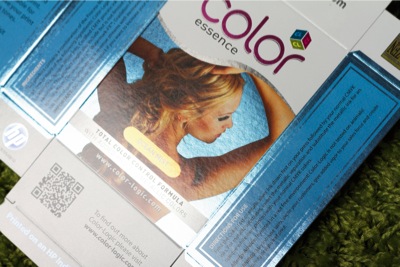 London HP Indigo printer 1st Byte produced this sample pack using white ink over Mirri Pak silver board.
London HP Indigo printer 1st Byte produced this sample pack using white ink over Mirri Pak silver board.
Metallic inks are available for several large format inkjets and one production class toner press. It has to be said that these are mostly duller than you can get with foils, covered below, but they do still catch the light, and the eye.
The only true metallic toner available for any digital production press so far is Kodak’s gold, introduced for fifth units of the latest Nexpress models and demonstrated on Digital Printer’s February 2013 cover. If you want silver or other shades on the Nexpress there is also a clear pearlescent toner that gives a rather muted metallic simulation over grey or pastel tints. There is also a bright pink toner. An inline UV varnisher was shown at drupa 2012, so you can get a special colour plus spot gloss.
Canon has long been able to achieve a similar sheen over pastels with the clear toner of its slowish ImagePress C1+ light production press.
Epson, Mimaki and Roland have metallic inks in some of their wide format eco-solvent inkjets. These produce a fairly dull silver, but you can overprint this with other colours to produce gold, bronze and other colours. These inks work with any eco-solvent media, including vinyl, window films and vehicle wraps.
Eckart, a German ink manufacturer specialising in metallics, offers its metallic Jetfluid inks for both solvent and UV curing inks. The solvent ink is available for Epson DX4, DX5 and DX6 printheads (used by Mimaki, Mutoh, Roland, Uniform and a bunch of Chinese models). The company now also has a metallic for UV cured inkjets (both mercury and LED lamps).
Samples of Eckart’s solvent silver printed on a Mimaki JV-33 are the closest we have yet seen to a mirror finish digital ink. The UV samples, printed on a JF Machines PicoColour 70 label press with Xaar 1001 heads, are rougher and grainy in appearance.
Foil application
While metallic inks have their uses, you will always get the best metallic effect by using real metal, as an ultra-thin foil layer on the substrate surface. Inkjet based foiling systems are now appearing that will open up the potential considerably.
The traditional way to get foil lettering or a pattern is to use foil blocking (often called hot foiling) with a heated metal die and modified conventional presses or platens.
This is a decidedly non-digital process as the metal dies are expensive and the image is fixed.
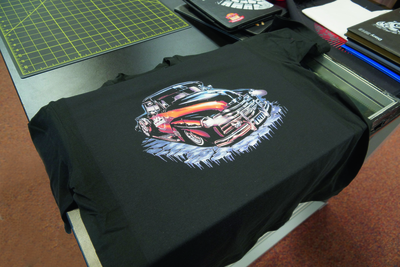 OKI’s white ink, seen here as the base layer on a teeshirt transfer made by TheMagicTouch in Dunstable
OKI’s white ink, seen here as the base layer on a teeshirt transfer made by TheMagicTouch in Dunstable
For many years it has been possible to get dieless short run foiling onto dry toner digital prints by heating a black toner printed image in a special application oven, with an adhesive foil layer pressed on top via rollers.
The adhesive is melted by the hot toner, and the foil sticks to the image area. This can be very effective, but is rather limited in terms of what printed images it will work with.
Cold foiling is a technique developed for offset presses, where a spot adhesive or sticky UV varnish is applied to the print and a foil roll brought into contact before the adhesive/varnish is cured.
At Ipex 2002, Inca Digital showed a prototype narrow web inkjet using API’s cold foiling film, but decided not to take it into production. More than a decade later, we are finally seeing inkjets used for true dieless variable image foiling.
First off is Digi-Foil, a new system developed by i-Sub Digital for Mimaki’s compact UJF A3 and A2 format UV flatbed printers, or its larger JF models. The foil is applied after printing as a separate sheet by hand roller, though director Andy Spreag is keeping precise details under wraps so far. He said that there is a wide choice of foil finishes on a slightly modified carrier film.
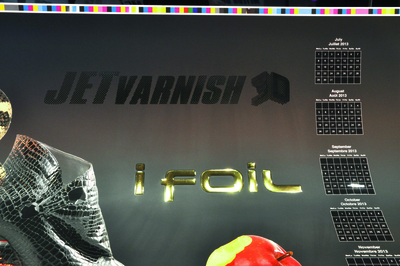 MIG produced this sample of its new iFoil over raised varnish on its JetVarnish 3D
MIG produced this sample of its new iFoil over raised varnish on its JetVarnish 3D
An additional advantage of the UJF is that it can handle 3D objects up to 150 mm thick. There are about 200 UJF installations in the UK. Production speed foiling is on the way from French manufacturer MGI, as a new unit on its high end JetVarnish 3D, a ‘long B2’ format inkjet based UV spot varnish press. Over the summer it has shown a prototype add-on unit called iFoil at a couple of exhibitions.
Unlike any other digital system, it can apply metal foil over ’embossed’ images. MGI’s vice president of marketing Kevin Abergel is not yet ready to reveal precisely how it works, but said that the first units will be offered to existing JetVarnish 3D users around the end of this year.
So far there is only one in the UK, at CPI White Quill in Croydon. However, they are selling well elsewhere, Mr Abergel said. Another alternative for foil application is via finishing equipment such as Kama’s ProCut 53 and 76, both of which now also have foiling options (see Finishing Line, page 52).
Reversals
The other way to get dieless foil effects with digital is to start with an overall foiled substrate and print an opaque white on top,
then print the coloured image over that. If you reverse out holes in the white layer artwork, the foil shows through. There is a wide choice of coloured, holographic or other effects, or you can choose plain silver and overprint it with transparent colours.
For instance, Celloglas has developed versions of its Mirri range of mirror finish metallised boards and papers that are certified by HP for use with Indigo presses. Mirri Pak for HP Indigo is supplied in plain silver, in 315 micron/220 gm2, 415 micron/280 gm2 and 460 micron/300 gm2. There is also an Indigo-certified version of Mirri Rainbow coloured-refraction material. The company offers a new lamination service onto the media of your choice.
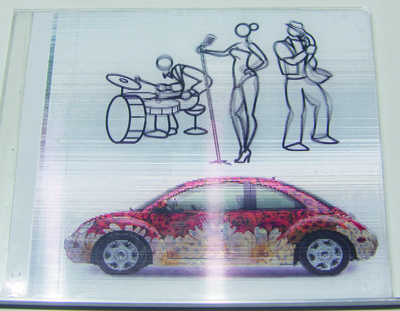 Scodix demonstrated this inkjet printed lenticular lens at drupa 2010. Although this lens covers the sheet, spot effects would be feasible
Scodix demonstrated this inkjet printed lenticular lens at drupa 2010. Although this lens covers the sheet, spot effects would be feasible
Scodix Metallic is a technique for printing its high gloss inkjet spot UV coating over a foil that can be laminated to any paper. The bare foil takes on a very bright reflectance after the Scodix coating is printed. It works well with the white reversal technique.
Kevin Abergel at MGI says that the same technique can be used with his company’s JetVarnish 3D inkjets, using metallised ‘Soft Touch’ laminates from Derprosa in Spain.
Opaque white inks are relatively common in large format inkjets, particularly UV flatbeds but some roll fed solvent types too. White is also starting to appear on narrow web digital label presses. However, white in production presses is rarer.
Xeikon has a white dry toner to run on the fifth units of both its 3000 series simplex label presses and 8000 series duplex commercial presses. It is mainly used with clear or metallised plastic label media, but would work with other substrates.
At drupa last year, HP introduced an opaque white liquid ink for its latest Indigo commercial production presses, the sheetfed 5500 and 7600, plus the web fed W6000P simplex flexible packaging and label press. Indigos can run up to seven colours as standard, so uniquely they can run white plus special colours.
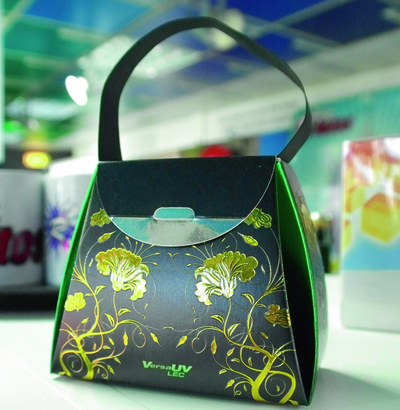 A sample pack with raised elements produced on a Roland VersaUV LEC 330 inkjet
A sample pack with raised elements produced on a Roland VersaUV LEC 330 inkjet
At the entry level, OKI introduced an opaque white toner for its new A4 C711WT and A3 C920WT printers last year, costing approximately £2000 and £5000 each (Digital Printer, February 2013). The white cartridge replaces the black, so can only be used with CMY colours. A five colour A3 model, ES9541, was announced in September, with the ability to print CMYK plus white or clear toner. This will arrive around year end, probably costing around £10,000.
DTP-Associates, developer of the X-Press OnDemand press range, uses modified OEM OKI engines. It has independently developed a system for running third party white, clear and several fluorescent toners in its four-unit DuraPress V and Q, 2400 and 4800. It calls this the ice toner range. In this case it runs two passes, with the black unit replaced by the special toner on the second pass. The other three colours are lifted off the paper to preserve lifetime.
Conclusion
Whisper it softly, but the majority of CMYK toner digital colour production presses produce more or less identical results: certainly good enough, but with little to distinguish one from the other. Being able to add affordable special effects such as metallics and spot/raised gloss may help printers to stand out from the crowd.
